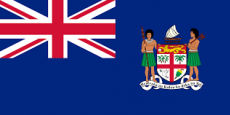

The decline of the British Empire – Fiji
The background to the colonial occupation of the country. Why did Britain take over?
The first people came to Fiji in around 1500BC, and in around 500BC Melanesians also began to arrive. In about 950BC, at the height of the Tongan Empire, Tongans began to attack parts of western Fiji, the evidence of these attacks can still be seen in the language and culture of Western Fijians’.
In 1822, the town of Levuka became the first European settlement in Fiji. The British were first offered Fiji in 1852 as long as Ratu Cakobau could keep his title as King of the Fijians, they declined this offer because they viewed this condition as unacceptable to both the British and the many other Fijian Chiefs.
In 1852, one of the leading chiefs, Ratu Cakobau, made himself the King of the Fijian’s, however, only the settlers recognize him as King. Unfortunately for Cakobau, he has debts to the settlers whose homes he destroyed whilst becoming King. The American Navy said that he must pay off the debts and threaten to shell Fiji if they don’t. To pay the debt Cakobau gives some Fijian land to the Australian Polynesia Company, who in turn pays off the debt. In 1871, increasing debts and threats from the US navy led Cakobau to establish a constitutional monarchy with a government dominated by European settlers. When this regime got into debt again, he offered the islands to Britain and they accepted on 10th October 1874. The islands were then ruled by the British for 96 years.
Fiji was important to the British Empire because it was abundant in fruits, vegetables, sandalwood, sea cucumbers, pearls. Convicts from Australia also went to the island of Ovalau (a Fijian Island) to make their fortunes in the mining and fishing industries.
What was life like under British rule? Were the occupiers welcomed or were there rebellions? If so, what happened?
The first governor of Fiji, Sir Arthur Gordon, was a decent person and developed a fatherly relationship with the native Fijians and instead of directly ruling he allows the native chiefs the freedom to run their own tribes without interference from the British; however they were forbidden to enter into tribal war. Gordon also introduced laws which prevented the natives from working in plantations; this prevented them from being exploited by plantation owners. He also introduced a law which prevented native land being sold, this meant that the natives would never be separated from their land and even now 83% of land in Fiji is still natively owned.
Because Fijians weren’t allowed to work in plantations, the plantation owners were desperate for workers and so Gordon decided to bring people over from India to work. Between 1879 and 1916 (when the last ship carrying Indians arrived in Fiji), 61,000 Indians came to Fiji.
What factors led to independence? How was independence achieved? Was the process carried out peacefully or was there conflict?
British rule in Fiji was mainly benign, the chiefs were allowed to stay and Fijians were allowed to run their own affairs. However in the late 1950s, newly formed labour unions called a general strike in December 1959, this eventually led to rioting by Fijians and Indians against European property. Even though the strike didn’t last long it was followed by a sugar workers strike the following year, which led to a march on the capital by sugar workers but it was turned back at Rewa Bridge by Fijian and New Zealander military forces.
Because of the strike the colonial government realized that postponing independence any longer would help no-one, so in spring 1963, they held the first election for members of the legislative council, in which everyone could vote. Ratu Mara was appointed chief minister and negotiations began between Alliance Party and the National Federation Party in 1969. The National Federation wanted a republic and no ties with the British, whereas the Alliance Party wanted to maintain close links with the Commonwealth.
In October 1969, the leader of the National Federation died and was succeeded by Siddiq Koya, who had a much better relationship with Ratu Mara and was prepared to compromise. An agreement was reached on 30th April 1970 and Fiji became independent on 10th October 1970.
Image- https://en.wikipedia.org/wiki/Colony_of_Fiji

0 Comment:
Be the first one to comment on this article.